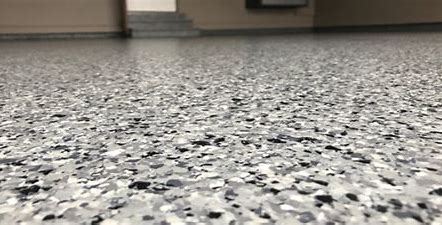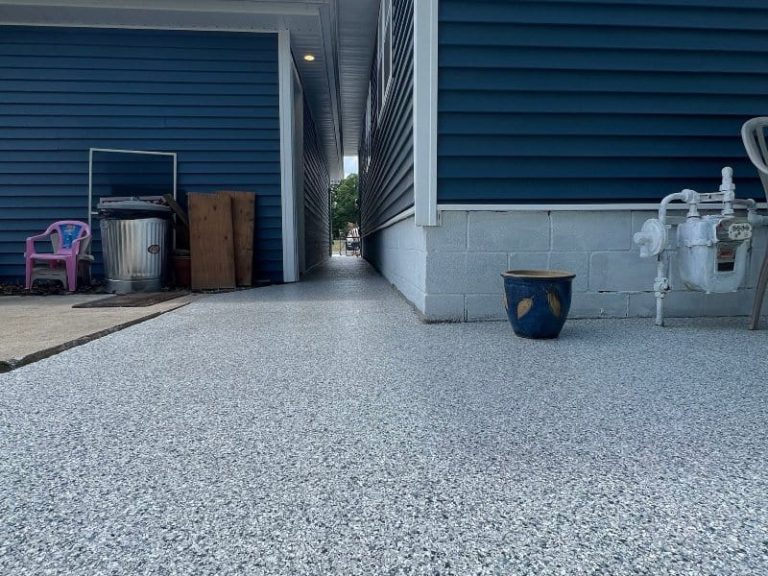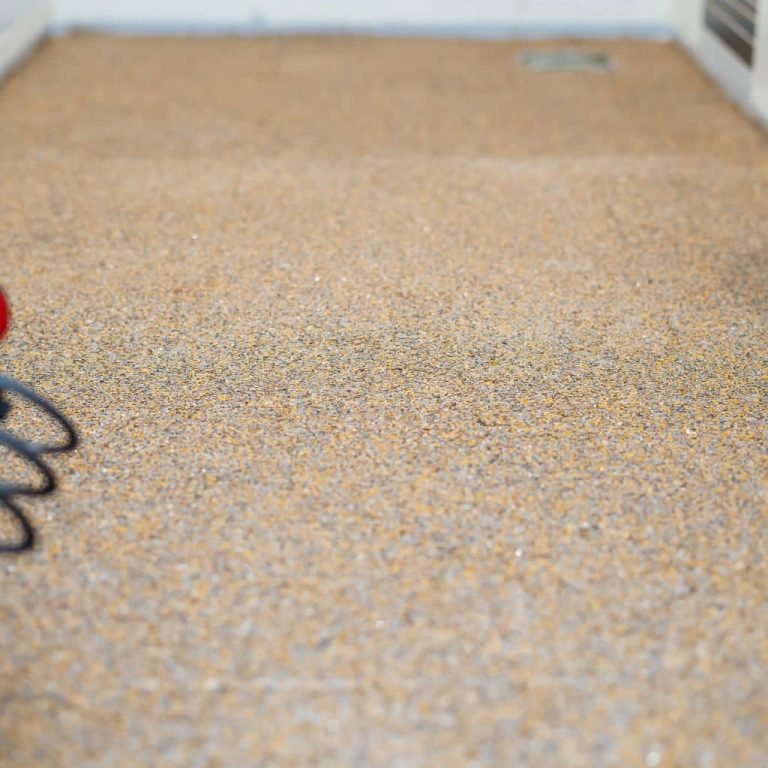Basement floors can be tricky. They’re often subject to moisture problems, prone to accumulating dust, and can feel chilly or unwelcoming. At the same time, a finished basement can be a major asset to your home—whether you convert it into a family room, a home office, or simply use it for storage. Choosing the right flooring is crucial for making it a space you’ll actually want to spend time in.
To help you figure out the best basement flooring options, we turned to concrete-coating expert Crayton Caudill of Level 10 Coatings, who serves Indiana and the Chicagoland area. In a recent interview, Crayton fielded a series of “People Also Ask” questions on everything from the cheapest way to cover a concrete basement floor to the best materials for dealing with a wet basement. Below, we’ll break down his insights and add a few tips of our own for a comprehensive guide to basement floor coatings.
Cheapest Way to Cover a Concrete Basement Floor
If budget is your number-one priority, you might wonder what the most economical route is. According to Crayton Caudill, the cheapest way to cover a concrete basement floor is to “wash it and buy a DIY epoxy and apply it.” Many big-box hardware stores sell epoxy kits designed for homeowners who want to take a do-it-yourself approach.
Pros of DIY Epoxy
- Cost Savings: Kits are relatively inexpensive. If you’re willing to handle the surface preparation, mixing, application, and cleanup yourself, you can save on labor costs.
- Instant Aesthetic Upgrade: Even a simple epoxy coat can transform a dull, gray concrete surface into something that looks cleaner and brighter.
- Availability: Most home-improvement stores have epoxy kits readily in stock, so it’s easy to pick one up and get started.
Cons of DIY Epoxy
- Shorter Lifespan: DIY epoxies often use lower-grade formulas compared to professional coatings. They may peel, crack, or yellow sooner—especially in areas prone to moisture.
- Surface Prep Challenges: Properly preparing the concrete (usually by acid etching or grinding) is absolutely crucial. Skimping here can lead to adhesion problems.
- Inconsistent Results: If you’re new to epoxy application, getting a flawless finish can be hard. You might see roller marks, bubbles, or uneven coverage.
For some homeowners, a cheap, short-term solution is perfectly acceptable. If your basement is purely for storage and you don’t mind re-doing the floor in a few years, DIY epoxy can work. However, if you’re looking for long-term quality and peace of mind, it’s worth exploring more durable options.
Best Flooring for a Wet Basement
“What is the best flooring for a wet basement?” As Crayton points out, the ideal solution starts by understanding why it’s wet in the first place. If you have active water seepage, you need to address that foundation or drainage problem before installing any type of flooring. Once the moisture issue is resolved, or at least well-managed, you can consider a basement floor coating.
Also, if your basement ever floods, make sure you hire a water damage restoration company to mitigate any further damage and restore the property back to it’s pre-loss condition. Then, feel free to call Level 10 Coatings to coat your floors!
Concrete Coatings for Damp Environments
Crayton states, “Depending on why it’s wet—once you have that rectified and you don’t get water in there—the best system for a basement is a concrete coating.” Here’s why:
- Moisture Tolerance: High-quality coatings (like polyurea polyaspartic systems) bond well to concrete and can tolerate mild dampness once it’s under control.
- Durability: Unlike traditional flooring materials (carpet, wood laminate, or vinyl planks), a resin-based coating won’t warp, rot, or develop mold in a basement setting.
- Seamless Finish: A concrete coating creates a continuous surface with minimal seams or grout lines, making it harder for water to infiltrate and easier to keep clean.
If you’re concerned about possible future leaks, a coating can buy you time. While no floor can withstand flooding indefinitely, a robust, water-resistant system ensures your basement doesn’t become a total loss after every minor plumbing mishap.
Advantages of a Basement Floor Coating
“Why choose a basement floor coating over standard finishes like carpet or tile?” Crayton highlights several key advantages:
- Easy to Clean: A coated floor repels dust, dirt, and spills. Sweeping or vacuuming is a breeze, and you can mop or wipe up messes with minimal fuss.
- Moisture Tolerance: Whether it’s humidity or a burst pipe, concrete coatings can handle basement-level moisture more gracefully than carpet or wood.
- Flood-Proofing Benefit: If you do experience a flood in your basement, you won’t have to rip out soggy carpet or warped planks. The coating may need some cleaning, but it won’t be ruined.
- Longevity: A professionally installed coating can last many years, offering a better investment return than cheap flooring that needs frequent replacement.
- Versatility: Modern coatings come in various finishes and colors, from sleek solid tones to decorative flakes that add texture and style.
These benefits become even more compelling if your basement is more than just a storage room—maybe you’re turning it into a rec area, a home gym, or an extra living space.
Beyond the Basement: Other Spaces That Benefit from Coatings
While talking about basement floors, Crayton mentioned a variety of other areas where a concrete coating can be applied. Essentially, if the concrete is in good shape and you can mechanically grind it to form a strong bond, then you can install a coating there. Some common examples include:
- Garage Floors: One of the most popular choices for a durable, chemical-resistant surface.
- Outdoor Spaces: Walkways, patios, pool decks, and front porches can all gain from a slip-resistant coating that stands up to the elements.
- Sunrooms: A bright, sunny area often means exposure to UV rays. A polyurea polyaspartic system resists yellowing far better than epoxy.
- Laundry Rooms and Mechanical Rooms: These areas see more moisture, detergents, or chemicals. A coating can protect the concrete slab underneath while making cleaning straightforward.
- Living Rooms (With Concrete Subfloors): Some modern interior designs embrace the industrial-chic aesthetic of a polished or coated concrete floor.
For commercial spaces, the list is even longer—warehouses, showroom floors, commercial kitchens, and more can benefit from resin-based coatings. The key takeaway? If you have concrete, you have coating potential.
How to Clean Flake Epoxy (or Other Resin-Based) Floors
If you choose a flake epoxy or similar system (like polyurea with decorative flakes), you may wonder about the best cleaning methods. Crayton notes that, “Cleaning a professionally done concrete coating is relatively easy.” The most common steps include:
- Basic Cleaning: A simple combination of water and a mild detergent (like Dawn dish soap or Simple Green) is typically enough for everyday dirt and grime. Dilute the soap in warm water, then use a sponge mop or soft-bristle brush to go over the floor.
- Rinse and Dry: After scrubbing, rinse off the soap with clean water. You can either squeegee out the water toward a drain (if your basement has one) or wipe it up with towels.
- Use a Specialized Cleaner: Many coating installers, including Level 10 Coatings, provide or recommend specialized products formulated for resin floors. These cleaners can help address tougher stains.
- Deep Cleaning (Post-Winter): If the floor looks especially dull after winter—perhaps due to salt or dirt—follow a more thorough routine. You can scrub two or three times and rinse after each pass. This will usually restore the shine.
- Avoid Harsh Methods Unless Necessary: Power washing or aggressive chemical cleaners can damage certain coatings if used improperly. Stick to mild solutions unless you have a severe stain, and then ask your installer for guidance.
One of the perks of a flake epoxy or polyurea polyaspartic floor is that it hides small specks of dirt or debris quite well. Even in a high-traffic basement, you won’t have to clean as often as you would with a lighter solid-color flooring option.
Professional vs. DIY: Weighing Your Basement Floor Options
Now that you know the cheapest option (DIY epoxy) and the best overall solution (professionally installed coatings) for a wet basement, how do you decide which is right for you? Let’s break down some considerations:
Budget and Longevity
- DIY Epoxy: Lower upfront cost, typically a shorter lifespan. If you’re comfortable redoing the floor in a few years, this might be enough.
- Professional Coatings (Polyurea or Polyaspartic): Higher initial investment but can last a decade or more—often 20 years or longer with proper installation. Over time, this may end up being more cost-effective.
Purpose of the Space
- Strictly Storage: If your basement is simply a spot for boxes, off-season clothes, or tools, the aesthetics may not matter as much. A cheaper DIY solution could suffice.
- Living Space or Workspace: If you regularly host gatherings, use it as a functional office, or spend a lot of time there, you’ll likely want a longer-lasting, better-looking floor. A professional coating might be the better choice.
Moisture Concerns
- Active Water Issues: No floor covering will fix leaks or seepage. You must address the root cause—like improving exterior drainage or fixing cracks in your foundation—before installing any type of floor.
- Mild Dampness or Occasional Spills: A quality basement coating shines in these conditions, resisting the mold and mildew issues that can plague carpets and other porous materials.
Installation Experience and Equipment
- DIY Approach: Are you comfortable with surface preparation (grinding or acid etching)? Do you have the tools to ensure a safe, dust-free environment?
- Professional Installation: Generally includes thorough prep work, repairs for cracks or spalling, and specialized products that cure faster and adhere stronger to the concrete.
Addressing Common Basement Myths
It’s easy to find conflicting advice on basement floors. Here are some myths and the facts behind them:
- Myth 1: “All Coatings Will Peel Up in a Basement.”
While improper prep can cause peeling, a well-prepared concrete surface and professional application dramatically lower that risk. - Myth 2: “Carpet Is Always the Coziest Option.”
Carpet can feel warm initially, but if any moisture issue arises, it can harbor mold and become musty. A coated floor with area rugs might be a safer, more versatile choice. - Myth 3: “You Can’t Get a Stylish Look from a Concrete Coating.”
Modern coatings come in endless colors, patterns, and finishes. You can choose subtle or bold flakes, metallic effects, or even custom logos. - Myth 4: “Basement Floors Should Be Painted, Not Coated.”
Regular paint won’t hold up well in a damp or high-traffic environment. Coatings are specifically engineered for durability and moisture resistance.
Tips for a Successful Basement Floor Coating
- Address Water First: Make sure you have no leaks or seepage before installing a new coating.
- Choose a Reputable Installer: If you opt for a professional approach, look for certified contractors with solid references.
- Invest in Proper Prep: The difference between a mediocre and a stellar outcome often lies in how well the surface is prepared.
- Consider Decorative Flakes or Pigments: Add a personal touch with flake blends or metallic finishes that complement your interior style.
- Plan for Maintenance: Even the best coating needs occasional cleaning. Knowing how to care for it extends its lifespan and keeps it looking new.
Bringing It All Together
From bare-bones DIY epoxy to top-tier polyurea polyaspartic, there’s a basement flooring solution for nearly every budget and purpose. Crayton Caudill’s advice underscores the importance of starting with a solid foundation—quite literally. Sort out moisture problems, pick a coating that suits your needs, and follow the recommended cleaning and maintenance tips.
If your basement is purely utilitarian, a quick epoxy job might do the trick. However, if you envision a versatile, long-lasting, and attractive space, consider investing in a professional installation. That approach gives you a floor that resists moisture, cleans up easily, and remains flood-proof in the event of future water issues.
Basement floor coatings don’t just serve a functional purpose—they can also enhance your home’s overall aesthetic and add resale value. With the right system in place, your basement transforms from an afterthought to a comfortable extension of your living space.
Conclusion
Choosing the right basement floor solution involves balancing cost, durability, style, and moisture control. Whether it’s a budget-friendly DIY epoxy or a more robust polyurea polyaspartic system installed by experts, the key is ensuring that any underlying water issues are addressed first. With that foundation in place, a concrete coating can provide a long-term, low-maintenance, and visually appealing surface—turning your basement into an asset rather than a liability.
If you enjoyed this conversation between Crayton Caudill of Level 10 Coatings & Will Troup of LocalSink, make sure you check out our other post, “Does a Polyurea Garage Floor Increase Your Home Value?“


